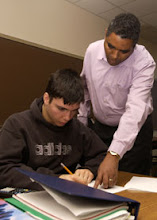We are on the verge of sleepwalking through yet another year—vaguely cognizant that our mental map of the world is sorely misaligned with reality, yet barely conscious enough to form a coherent question about how.
Albert Einstein offers an insight worth reflecting on. He posited that the thinking we use to solve our problems is in reality the source of our problems. The Greenspan 2008 epiphany is an apt illustration. Appearing before a congressional panel investigating the evolving financial crisis, he admitted "a flaw" in his view of world markets, despite “very considerable evidence that it was working exceptionally well” for forty years or more. To his credit, though, Alan Greenspan is, perhaps, the only leader on record to acknowledge that his mental model of the world had fallen out of sync with reality. Despite this shocking admission by such a highly revered economic-seer, decision-makers and politicians alike have insisted on clinging to out-moded thinking about how the economy operates in reality.
Daily the news pours out evidence indicting the very thinking used to solve our problems.
…deleveraged of assets, homelessness on the rise
…rebound recession worries imported from abroad; yet, $1.6 T. safely tucked away by US banking system
…military spending on autopilot, while investment in people—the true pillars of growth—stagnate
…tax breaks—a runaway train speeding to “Utopia” (Greek for no place), despite proof that higher top income tax rates produce far more jobs
Einstein is also quoted as having defined insanity: doing the same thing over and over again and expecting different results.
2012 is an excellent time to get off the insanity treadmill and reboot our mental models to better align with reality—a reality steeped in uncertainty, complexity and in need of new leadership attuned to this new reality.
Consider Joshua Ramo’s book The Age of the Unthinkable: Why the New World Disorder Constantly Surprises Us and What we Can Do About it (2009). He passionately describes the melt-downs in the global order arising from mismatched mental images and plans for action. When we don’t see the world as a system, we miss the indirect linkages that hold the power to cascade change through a system in response to a direct challenge. He offers his book as a guide to how we can save ourselves—a “decoder ring for the perplexities of our current world, for the dangerous magic that seems to be unspooling everywhere. And it is also, once you’ve understood it clearly, a way for anyone, from eight to eighty, to begin to see what this world means for you — and to see what you can do about it.” (8)
Consider Rebecca Costa’s book The Watchman’s Rattle: Thinking Our Way Out of Extinction (2010). She succinctly identifies the key of our current woes: “The primary cause of all threatening trends is the complexity of civilization itself, which can’t be understood and managed by the cognitive tools we have thus far choose to use. (xi) She argues that our cultural tendency is to focus on the symptoms which we can wrap our head around rather than the underlying problem tangled in a web of complexity. We grab quick-fix solutions for what appear the obvious symptoms but make ourselves more vulnerable to their dangerous consequences. From Costa’s perspective the key to survival is revving up the way a culture ‘thinks’ to match the complexity rate of the external environment—the part of the environment over which we have no direct control, often little knowledge but holds the power to decimate our lives.
Consider Margaret Wheatley’s book Leadership and the New Science: Discovering Order in a Chaotic World (2006). My chance encounter with this one sent my head spinning! Wheatley offers hope when she asserts that "[a] system can descend into chaos and unpredictability, yet within that state of chaos the system is held within boundaries that are well-ordered and predictable." (13) Every living system changes to preserve itself. To do so, however, requires that system maintain a clear sense of identity and freedom of choices, while self-organizing to a higher level of complexity better matched to its environment. Everywhere, life self-organizes as networks of relationships, thereby, making relationships the “basic building blocks” of life.
May tomorrow be the day you step off the insanity treadmill and challenge your own thinking about reality as it is—not as it once was.
 Kay Strong, Ph.D., Southern Illinois University, M.T., University of Houston, M.A., Ohio University; Associate Professor at Baldwin-Wallace College; Areas of expertise: international economics, contemporary social-economic issues, complexity and futures-based perspectives in economics. E-mail: kstrong@bw.edu
Kay Strong, Ph.D., Southern Illinois University, M.T., University of Houston, M.A., Ohio University; Associate Professor at Baldwin-Wallace College; Areas of expertise: international economics, contemporary social-economic issues, complexity and futures-based perspectives in economics. E-mail: kstrong@bw.edu

